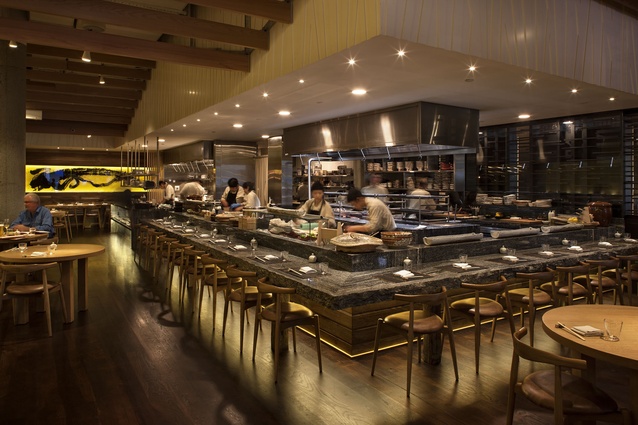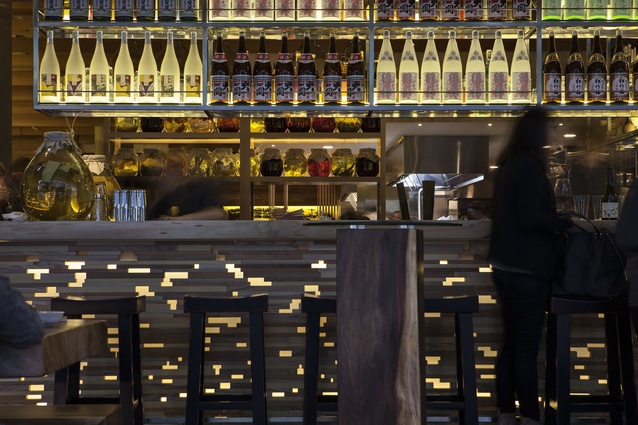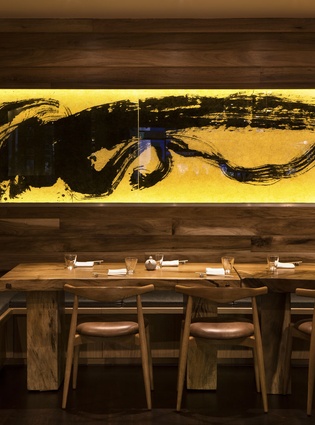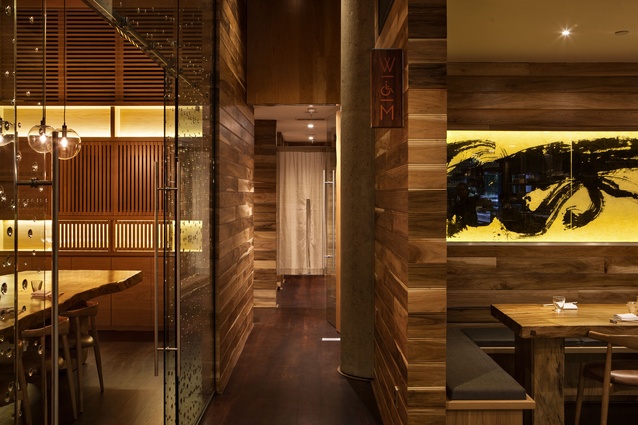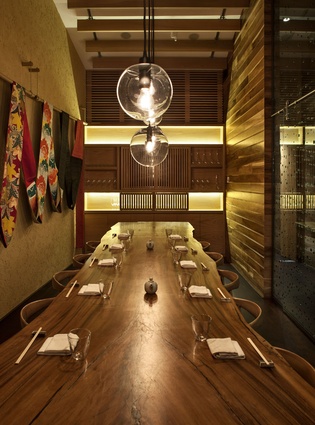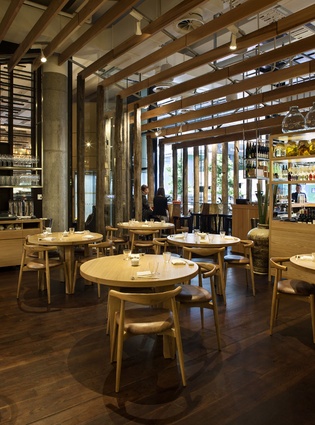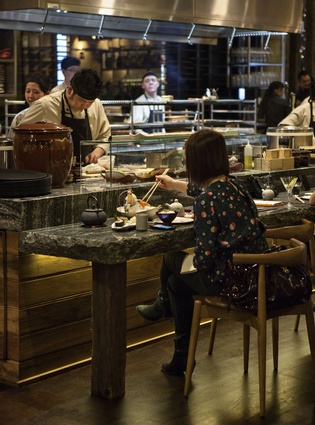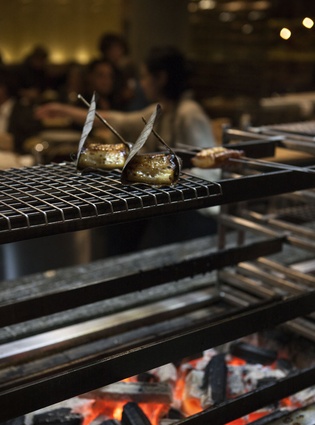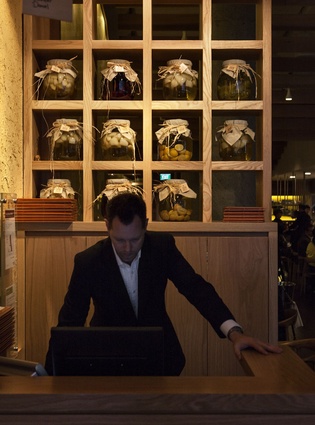Masu
Fortune and abundance are two words that come to mind when considering Masu, the latest restaurant to grace Sky City’s food and beverage precinct in Federal Street.
Nic Watt’s first encounter with fortune occurred when he was invited by Sky City to be a celebrity guest chef at a charity fundraising event. Watt is an internationally fêted chef, known for establishing Japanese robata-style restaurants under the Roka brand in London, Macau, Hong Kong and America. Sky City CEO Nigel Morrison was sitting at the table for which Watt was cooking and was impressed. Soon after, plans were made to establish a restaurant. Watt, in association with Sky City, appointed Moller Architects to develop and implement his vision for the space. Watt was a very discerning client, engaged in all aspects of the design process. Many details found within the interior develop and extend a design repertoire rehearsed in his earlier restaurants.
Masu refers to a wooden box used to measure rice, when rice was a form of currency in Japan. Contemporary masu boxes are much smaller, and used as repositories for sake cups, which are filled to overflowing to express an abundance of generosity. Watt was intent on capturing that generosity and good fortune in his restaurant. The rich spatial and material registers employed in this project convey an understated largesse. The menu serves to emphasise this by offering a carefully curated selection of small dishes designed to be shared.
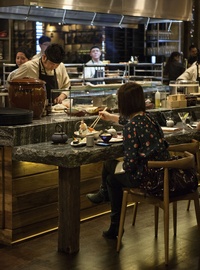
Masu provides a modern interpretation of traditional robata cooking over an open charcoal grill. This ancient cooking method was first used by Japanese fishermen and was centred around a communal hearth. The hearth of Watt’s contemporary restaurant remains the robata grill. It is the nucleus – a centre point visible to all patrons, inviting them to be part of the culinary performances played out in the open kitchen. Watt also believes a natural trust is established when patrons can see the chefs working.
The architects maintained the high ceilings of the existing space, painting the service ducts white and installing a series of western red cedar rafters to create the illusion of a new roof supporting the space. This gesture serves to make the space feel more intimate.
The layout of the dining room and the selection of finishes were chosen to be in harmony with the cuisine, designed, according to Watt, to ‘enhance one hero ingredient’. This line of thought influenced how unique interior elements could differentiate key areas within the restaurant while also feeling integrated into the overall design. These key areas are the entry, the shochu bar, the robata grill, the chef’s kotatsu table and the private dining area, the Obi Room.
Designsource worked closely with Watt and Moller Architects on this project, sourcing materials and commissioning artisans to finish them to the project team’s exacting specifications.
As you enter the restaurant, you walk beneath people’s good wishes, suspended in the purpose-built Wishing Chandelier. This design element makes reference to the entry thresholds of Japanese Shinto shrines, where worshippers write their prayers or wishes on ema (small wooden plaques). The ema are left hanging at the shrine, where the kami (spirits or gods) receive them.
The refined, formal character of Masu’s wooden chandelier is counterpointed by the tactile finish of the specially commissioned earth wall, made by Bernard Willems of Ambitec. Earth walls are another architectural element found in celebrated temple designs.
The bar area is adorned with Italian kume jars of various sizes, containing shochu, a traditional medicinal spirit that has been updated, using flavour profiles such as strawberry, pineapple, lychee, cherry and plum. The infusions add vivid colour to the heavy-set macrocarpa counter top and bring to mind an apothecary’s dispensary. However, any thoughts of nostalgia are swiftly erased when you view the de-oxygenated ice block positioned beside them. Lit from below, this incandescent monolith is hand chipped and added to tonics (it is so dense, it does not melt but serves to chill the infusions). In the bar, there is a canny integration of ancient methods with new technologies. This reinterpretation of tradition informs many of the spatial and material gestures in the interior design.
The Robata Bar accommodates patrons immediately in front of the open kitchen. It is made from alpine grey granite with a rusticated edge, producing an organic seating line. Watt and Moller Architects specified the particular boulders to be cut, choosing the granite for its unique movement and veining. The care and attention paid to the Robata Bar is extended to the vessels chosen to contain the food. Watt commissioned Californian-based artist Ryusei Arita, whose work can be found in the collections of San Francisco MOMA, to make a selection of wood-fired ceramic serving dishes for the restaurant.
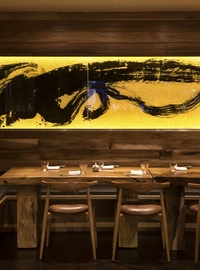
The chef’s table is ensconced at the back of the restaurant and is served directly by the chef’s open kitchen. The layout of this space is inspired by the kotatsu table, a traditional Japanese table with a heat source placed beneath it, often recessed into the floor. During the winter months, the kotatsu is the centre of domestic life as families gather around it to eat, talk and keep warm. The designers have created a sense of warmth and enclosure without cutting the floor away or enclosing the space.
The table is bathed in a golden light. This emanates from the feature artwork, Dragon, produced by Japanese calligraphy artist Ushio Sekiguchi, on handmade Japanese washi paper. A contemporary take on tradition is also evident in the selection of upholstery materials that clad the built-in seating, which, in their texture and colour, share a kinship with traditional tatami mats.
The private dining area, the Obi Room, is named after the sash of a Japanese kimono. The room is separated from the more spacious dining volume by a large area of glass punctuated by small glass bubbles. This subtle, effervescent surface treatment not only provides a degree of privacy but also connects to the theatre of the robata grill outside.
The table, designed to seat 18, is crafted from a single piece of suar wood. Earth walls are graced with a display of vintage Japanese obi, resplendent with fine, colourful patterns. One of the patterns was photographed and made into a transfer to adorn the espresso machine in the bar area, ensuring every element of the design was seamlessly integrated into the conceptual schema.
The space Masu occupies was once part of Sky City Grand Hotel’s capacious lobby. The area co-opted by the restaurant has been carefully detailed to ensure the new intervention gives something back to its neighbours – the hotel lobby on one side and the convention promenade on the other. This has been achieved by creating openings between the lobby and Masu so patrons of the restaurant and the hotel can catch glimpses of one another. Space borrowed from the convention promenade was used to construct a curved wall in the restaurant with banquette seating. This interior wall is made from large spans of glass with coloured washi paper laminated between them, casting a flattering amber glow on patrons. The other side of the wall is clad in gold polished stainless steel and serves to bring light into the convention promenade and reflect the multitude of sepia tones in Dick Frizzell’s 60m-long mural on the opposite wall.
Moller Architects has worked closely with Watt to produce a range of unique, yet integrated dining experiences. Every millimetre of Masu’s interior has been carefully considered and made to measure. Design elements have been gleaned from Japanese social and cultural life and reimagined for a local context. The materials used are treated with great care, resulting in an interior space that demonstrates a measured balance between finely honed, patterned and rusticated finishes that complement the meticulous attention to detail found in Watt’s culinary offerings.

